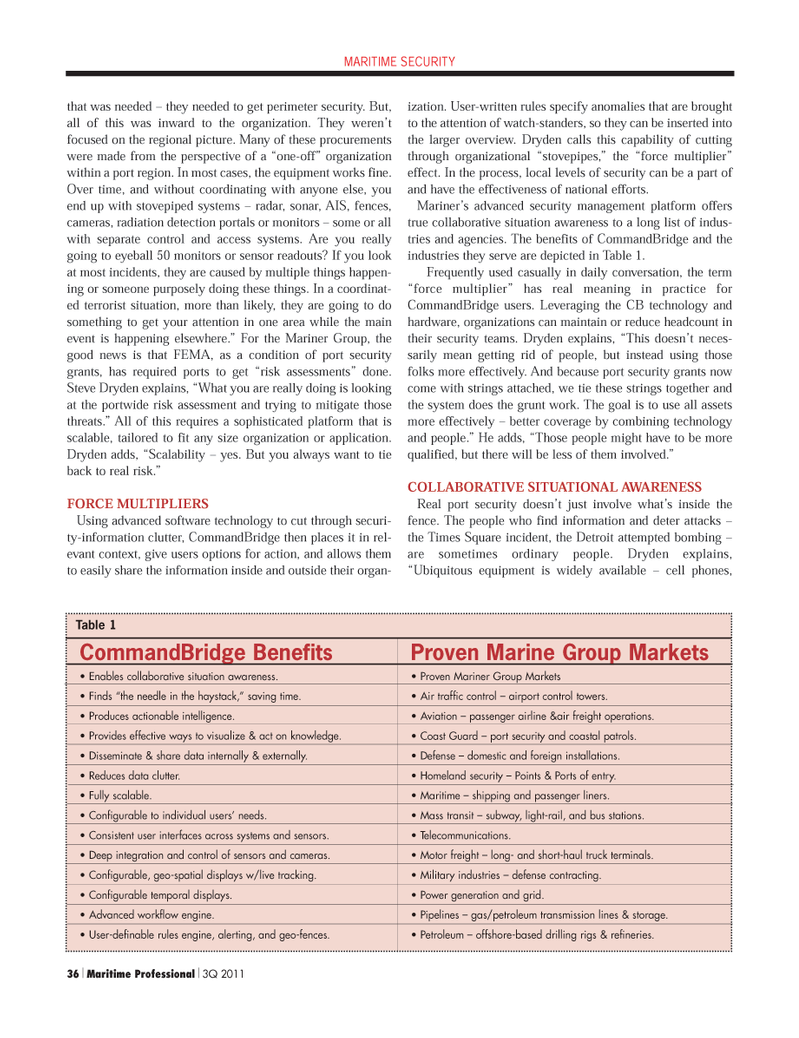
Page 36: of Maritime Logistics Professional Magazine (Q3 2011)
Maritime Security / Maritime Training & Education
Read this page in Pdf, Flash or Html5 edition of Q3 2011 Maritime Logistics Professional Magazine
36 Maritime Professional 3Q 2011that was needed ? they needed to get perimeter security. But, all of this was inward to the organization. They weren?t focused on the regional picture. Many of these procurements were made from the perspective of a ?one-off? organization within a port region. In most cases, the equipment works fine. Over time, and without coordinating with anyone else, you end up with stovepiped systems ? radar, sonar, AIS, fences, cameras, radiation detection portals or monitors ? some or allwith separate control and access systems. Are you really going to eyeball 50 monitors or sensor readouts? If you look at most incidents, they are caused by multiple things happen- ing or someone purposely doing these things. In a coordinat-ed terrorist situation, more than likely, they are going to do something to get your attention in one area while the mainevent is happening elsewhere.? For the Mariner Group, the good news is that FEMA, as a condition of port security grants, has required ports to get ?risk assessments? done.Steve Dryden explains, ?What you are really doing is looking at the portwide risk assessment and trying to mitigate thosethreats.? All of this requires a sophisticated platform that is scalable, tailored to fit any size organization or application. Dryden adds, ?Scalability ? yes. But you always want to tie back to real risk.? FORCE MULTIPLIERS Using advanced software technology to cut through securi- ty-information clutter, CommandBridge then places it in rel-evant context, give users options for action, and allows them to easily share the information inside and outside their organ- ization. User-written rules specify anomalies that are brought to the attention of watch-standers, so they can be inserted into the larger overview. Dryden calls this capability of cutting through organizational ?stovepipes,? the ?force multiplier? effect. In the process, local levels of security can be a part of and have the effectiveness of national efforts. Mariner?s advanced security management platform offers true collaborative situation awareness to a long list of indus- tries and agencies. The benefits of CommandBridge and the industries they serve are depicted in Table 1. Frequently used casually in daily conversation, the term ?force multiplier? has real meaning in practice forCommandBridge users. Leveraging the CB technology and hardware, organizations can maintain or reduce headcount in their security teams. Dryden explains, ?This doesn?t neces- sarily mean getting rid of people, but instead using those folks more effectively. And because port security grants now come with strings attached, we tie these strings together andthe system does the grunt work. The goal is to use all assets more effectively ? better coverage by combining technology and people.? He adds, ?Those people might have to be more qualified, but there will be less of them involved.? COLLABORATIVE SITUATIONAL AWARENESS Real port security doesn?t just involve what?s inside the fence. The people who find information and deter attacks ? the Times Square incident, the Detroit attempted bombing ? are sometimes ordinary people. Dryden explains, ?Ubiquitous equipment is widely available ? cell phones, MARITIME SECURITYCommandBridge Benefits Enables collaborative situation awareness. Finds ?the needle in the haystack,? saving time. Produces actionable intelligence. Provides effective ways to visualize & act on knowledge. Disseminate & share data internally & externally. Reduces data clutter. Fully scalable. Configurable to individual users? needs. Consistent user interfaces across systems and sensors. Deep integration and control of sensors and cameras. Configurable, geo-spatial displays w/live tracking. Configurable temporal displays. Advanced workflow engine. User-definable rules engine, alerting, and geo-fences. Proven Marine Group Markets Proven Mariner Group Markets Air traffic control ? airport control towers. Aviation ? passenger airline &air freight operations. Coast Guard ? port security and coastal patrols. Defense ? domestic and foreign installations. Homeland security ? Points & Ports of entry. Maritime ? shipping and passenger liners. Mass transit ? subway, light-rail, and bus stations. Telecommunications. Motor freight ? long- and short-haul truck terminals. Military industries ? defense contracting. Power generation and grid. Pipelines ? gas/petroleum transmission lines & storage. Petroleum ? offshore-based drilling rigs & refineries. Table 1 MP #3 (34-49):MP Layouts 8/17/2011 4:22 PM Page 36

 35
35

 37
37
